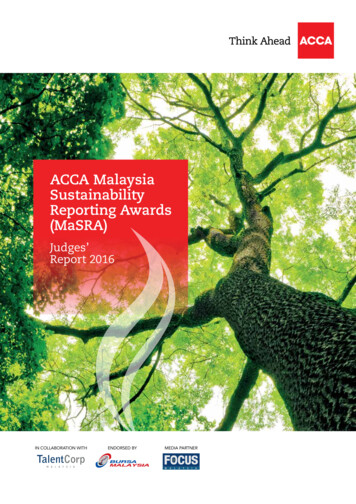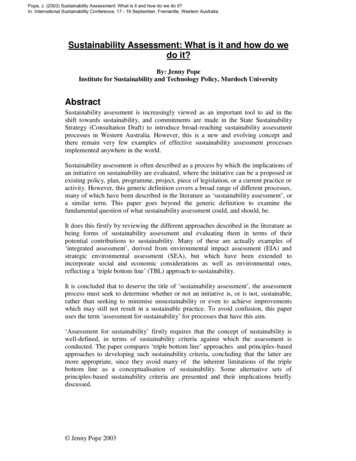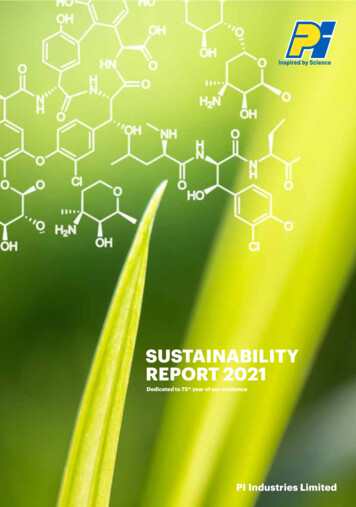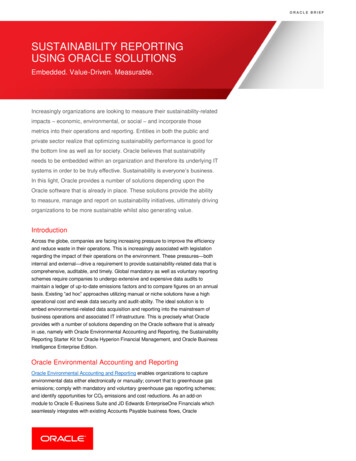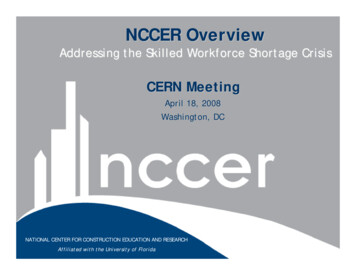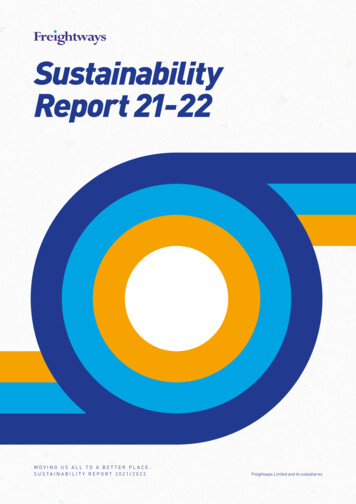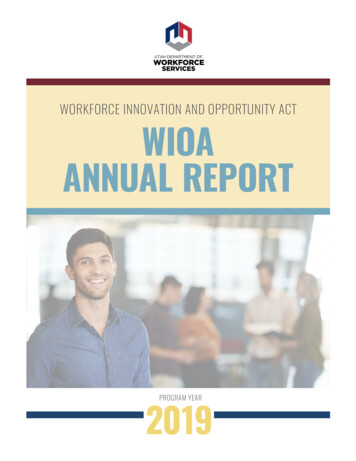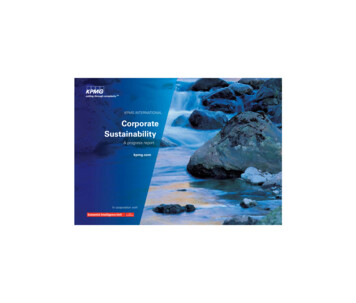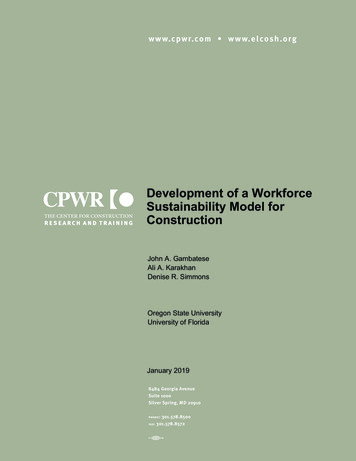
Transcription
w w w. c p w r. c o m w w w. e l c o s h . o r gDevelopment of a WorkforceSustainability Model forConstructionJohn A. GambateseAli A. KarakhanDenise R. SimmonsOregon State UniversityUniversity of FloridaJanuary 20198484 Georgia AvenueSuite 1000Silver Spring, MD 20910phone :fax:301.578.8500301.578.8572
2019, CPWR-The Center for Construction Research and Training. All rightsreserved. CPWR is the research and training arm of NABTU. Production of thisdocument was supported by cooperative agreement OH 009762 from theNational Institute for Occupational Safety and Health (NIOSH). The contents aresolely the responsibility of the authors and do not necessarily represent theofficial views of NIOSH.
Final ReportTitle:Development of a Workforce Sustainability Model forConstruction(Small Study No. 17-8-PS)Submitted to:The Center for Construction Research and Training (CPWR)Researchers:John A. GambateseProfessor, School of Civil and Construction EngineeringOregon State UniversityAli A. KarakhanPhD Candidate, School of Civil and Construction EngineeringOregon State UniversityDenise R. SimmonsAssociate Professor, Engineering School of Sustainable Infrastructure andEnvironmentUniversity of Florida
Workforce Sustainability ReportAbstractThe physical work environment in construction is often intense. It can place physical demandson workers and expose workers to adverse conditions that are not present in other industries. Theintense environment negatively affects the construction workforce, leaving minimal perceivedvalue and incentive for new workers to enter the industry and the existing workforce to remain inthe industry. The construction workforce has experienced high turnover rates and poor safetyperformance over the last few decades. Achieving diversity and equity are also top concerns inthe construction industry. Many construction organizations do not invest in workforcedevelopment and have no long-term plans to cultivate the workforce. This deficiency may be akey reason behind the perceived low value of being an employee in the construction industry.Moreover, there are no holistic tools and resources available across the industry to helporganizations cultivate the construction workforce. This research study was intended to fill thisgap in practice by developing informed tool to assess and improve workforce sustainability (i.e.,continuing workforce development) in construction. Using a mixed-methods research approachthat relied on semi-structured interviews and informal discussions with industry professionalsand academics, a review of the literature, and a multi-round subject matter expert survey, aworkforce sustainability assessment tool was developed. The developed tool includes three levelsof components (attributes, indicators, and metrics) to characterize a workforce and assess itslevel of sustainability.Keywords: Workforce development, social sustainability, equity, diversity and inclusion,training and education, competence, and maturity.Key Points Summary Achieving workforce sustainability includes the process of hiring and facilitating anenvironment for a coherent, viable, and healthy individuals who are highly skilled andcompetent, and then nurturing and maintaining the requisite skills and competenciesconstantly.A practical tool consisting of a model and evaluation process is developed to assess andimprove workforce sustainability in the construction industry. The developed tool isreferred to as a workforce sustainability assessment tool.The workforce sustainability assessment tool consists of three levels of componentsorganized in a hierarchy, from the most general to the most specific. The three levels ofcomponents are attributes, indicators, and metrics, respectively.The workforce sustainability tool includes eight attributes (nurturing, diversity, equity,health and well-being, connectivity, value, community, and maturity) synthesizingimportant features to characterize a workforce and reveal its level of sustainability. Fori
Workforce Sustainability Report each attribute, multiple indicators are recognized and collectively used to assess andimprove the attribute. In total, 42 indicators of workforce sustainability are identified inthe study. In turn, for each indicator, a metric (a measurement unit with different scales)is determined and used to quantify the indicator.The workforce sustainability score, calculated from the aggregated values and weights ofthe attributes, indicators, and metrics using the described tool, ranges from 7.5 to 29. Thisrange of values is divided into three levels of workforce sustainability: high (score higherthan 21), intermediate (score ranges from 13 to 21), and low (score lower than 13). Foreach level, a different action is required to improve workforce sustainability within anorganization.ii
Workforce Sustainability ReportTable of ContentsAbstract . iKey Points Summary . iIntroduction . 1Literature Review. 2Research Objectives . 4Research Methods, Tasks, and Accomplishments . 5Deviations from Plan . 22Future Research Plans . 22Dissemination Plan and Publications . 23References . 23Appendices . 26Appendix II (Delphi Questionnaires)Appendix II (Workforce Sustainability Indicators)Appendix III (Workforce Sustainability Assessment Tool)iii
Workforce Sustainability ReportIntroductionThe unique nature of building construction and high degree of organizational complexity onjobsites make the construction industry one of the most hazardous (BLS 2016) and wastegenerating (EPA 2016) industries in the United States (US). For example, the number of workrelated fatal injuries in the construction industry was the highest among all US industries in 2015(BLS 2016). Even though construction comprises a small percentage of the overall USworkforce, about 20% of the total occupational fatal injuries in the US are associated withconstruction operations (Abdelhamid and Everett 2000). The industry is taking steps to improvethe safety and health of its workforce, yet continued efforts and vigilance are needed to preventfurther injuries and fatalities from occurring.Sustainable development is, in part, expected to reinforce social equality, health, and wellbeing of construction stakeholders. The US Green Building Council’s (USGBC) Leadership inEnergy and Environmental Design (LEED) rating system, the most widely used green buildingrating system in the US construction industry, is designed to promote sustainable development.The rating system focuses primarily on environmental and economic aspects of sustainabilityassociated with the design, construction, and use of facilities. Unfortunately, the rating system islimited in its attention to the social context of sustainability, especially worker health and safety(Hinze et al. 2013). In order to attain a sustainably safe industry, social sustainability mustreceive high priority in the construction industry. Social sustainability in construction can bedescribed as “a life-enhancing process to accomplish social equity among all constructionstakeholders [including construction workers] in terms of health, education, economic welfare,and other human rights” (Karakhan and Gambatese 2017). As sustainable development is acomprehensive vision to holistically address the environment, economy, and society, commonpractices for implementing sustainability in the US construction industry can be consideredincomplete. Previous studies have indicated that LEED rating system credits predominantlyoverlook the impact of construction operations on worker health and safety (NIOSH 2010).To respond to this deficiency and sustain workers’ health and safety throughout theirworking lives and beyond, workforce sustainability must be clearly defined, measurable,achievable, results-focused, and time-bound. Based on a comprehensive literature search, theresearchers found no prior studies that provide a model or framework for assessing workforcesustainability in construction. The present study is intended to bridge this gap in knowledge andpractice by developing a practical model of workforce sustainability for construction. Workforcesustainability is defined by the investigators as a property of a workforce that reflects the extentto which the workforce can perform its desired function over a selected period of time. Aworkforce may exhibit a high or low level of sustainability based on the extent to which it safely,skillfully, and collaboratively performs its function. The time period over which workforcesustainability is assessed may be a defined finite period of time or indefinitely. A workforce may1
Workforce Sustainability Reportbe self-sustaining or require external inputs to maintain its presence and ability to perform itsdesired functions. Workforce sustainability can be “created and nurtured via employmentpractices, [procedures, and policies] that link employee work-life balance and well-being toemployment experiences over the course of employees’ working lives, enabling them to performwell over time while also thriving in their personal and family lives” (Kossek et al. 2014). Thedeveloped workforce sustainability model is expected to promote providing a sustainable careerfor construction workers and a sustainable industry for all construction stakeholders. This goal isin line with the overall mission of the National Institute for Occupational Safety and Health(NIOSH) and The Center for Construction Research and Training (CPWR).It should be emphasized that, for the purpose of this study, the construction workforceconsists of all members of a construction-related organization who are involved, directly orindirectly, in the construction process, whether laborers, managers, supervisors, engineers, orother individuals.Literature ReviewA review of literature indicates that the extreme workplace conditions in the constructionindustry may impact the construction workforce negatively. Over the past ten years, theconstruction industry has consistently incurred high numbers of occupational fatal and non-fatalinjuries. In 2015 alone, 937 fatalities were reported in construction according to the Bureau ofLabor Statistics (BLS 2016). The hazardous nature of construction work limits interest inemployment in the industry. The relatively low level of productivity in construction comparedwith other industries (e.g., manufacturing) reported in literature (Allmon et al. 2000; Rojas andAramvareekul, 2003) is another example of the extreme workplace conditions in construction.Figure 1 illustrates the discrepancy between worker productivity in construction relative to otherUS industries.Moreover, the CPWR Chart Book indicates that the labor force within the constructionindustry is aging (CPWR 2013). The proportion of older workers in the workforce (workers agedbetween 45-65 years) increased from 25% to 39% between 1985 and 2010, while the proportionof younger members of the workforce (workers aged under 35 years) significantly decreased byroughly 50% over the same period of time (CPWR 2013). In addition, education attainment ofthe construction workforce is lower than that in all other US industries except for agriculture(CPWR 2013). The work environment in the construction industry is intense. Many constructionlaborers work more than 40 hours per week in extreme environments (CPWR, 2013). Longworking hours influences a person’s health and prosperity adversely and can lead to conflictsbetween work and family responsibilities (Pfeffer 2010), causing work-life stress and potentialperformance errors in the workplace (e.g., safety incidents).2
Workforce Sustainability ReportFurthermore, the construction industry has been consistently identified as an industry thatdoes not attract skilled and new workers anymore. Among Millennials (the generation of peopleborn between 1982 and 2002), there is convincing evidence that a large percentage of highschool students, both males and females, is reluctant, if not resistant, to pursuing a career relatedto construction (Escamilla and Ostadalimakhmalbaf 2016).Figure 1: Labor Productivity Index for Construction Industry vs. Other IndustriesBased on the aforementioned circumstances, there is an essential need to improve workforcesustainability in construction. This study aims to address this industry issue by developing aworkforce sustainability model that incorporates essential attributes and applicable indicatorsneeded to assess and improve workforce sustainability in construction. The model is designed toinclude considerations for multiple aspects of the construction workforce, such as work-lifebalance, skill development, education attainment, and diversity. Successful development of themodel provides a practical tool to assess and improve workforce sustainability in practice. Thereis currently no similar tool available to enable construction stakeholders, including organizationsand employers, to assess and improve the level of sustainability with respect to the workforce.Previous studies primarily focused on either organizational sustainability or sustainability of aspecific facility based on its design/construction, as opposed to sustainability of a workforce.Valdes-Vasquez and Klotz (2013) developed a framework to characterize the necessaryconsiderations of social sustainability within construction organizations. The frameworkpredominantly focused on organizational sustainability, rather than on the workforce. Relatedly,Rajendran (2006) created the Sustainable Construction Safety and Health (SCSH) rating system3
Workforce Sustainability Reportto evaluate and sustain worker safety and health on construction projects. The SCSH ratingsystem is limited to the project level and only considers occupational health and safety in itsevaluation process, without addressing other critical elements of workforce sustainability, suchas equity and diversity. A realistic and holistic sustainability model should ideally includemultiple attributes to characterize critical qualities of the workforce. In such as model, workerhealth and safety would ideally be only one attribute of the model. The development of such aholistic tool is an important contribution to scientific knowledge because it could enableresearchers to study, quantify, and investigate trends and phenomena with respect to workforcesustainability (e.g., investigating the relationship between workforce sustainability and keyproject performance indicators such as workplace safety, work quality, and productivity).Research ObjectivesAs mentioned above, the primary goal of this study is to develop a workforce sustainabilitymodel for construction. The study involved the identification and quantification of essentialattributes that affect workers’ lives and careers in construction and, hence, constructionworkforce sustainability. One unique aspect of the study and model is that they were based onthe perspective of the workforce and how workers feel with respect to their employment. That is,the model addresses sustainability from the worker’s perspective, not from the perspective of theemploying organization or the project stakeholders. The model developed is intended to be apractical tool to assess and improve workforce sustainability in construction at the team,division, company, and industry levels.The specific objectives of the study to attain the overall research goal were to:1. Identify essential attributes that characterize critical qualities and characteristics of aworkforce and assess its level of sustainability;2. Assign a weighting to each attribute that reveals the level of influence that each attributeshould have on workforce sustainability;3. Identify and quantify applicable indicators for assessing and improving each attribute ofworkforce sustainability; and4. Develop a formal workforce sustainability model and an evaluation process for assessingand improving workforce sustainability in the construction industry.To achieve the study objectives, four tasks were planned for this study as follows:1. Construct a conceptual model of workforce sustainability that recognizes the essentialkey attributes of workforce sustainability (Objective #1);2. Identify, select, and qualify a panel of experts on the topic of workforce sustainability(Objectives #1, #2, and #3);4
Workforce Sustainability Report3. Develop a questionnaire and conduct a multiple round Delphi survey to identify/verify andquantify workforce sustainability attributes and indicators (Objectives #2 and #3); and4. Develop a practical workforce sustainability model and evaluation process to assess andimprove workforce sustainability (Objective #4).Research Methods, Tasks, and AccomplishmentsA mixed-methods research approach that relied on semi-structured interviews and informaldiscussions with industry professionals and academics, a review of literature, and a Delphiprocess was carried out to perform the research tasks listed above. Each task, along with themethods used and the results achieved, is presented below.Task #1: Construct a conceptual model of workforce sustainability that recognizes theessential key attributes of workforce sustainabilityTo achieve this task and construct a workforce sustainability conceptual model, semi-structuredinterviews and informal discussions with industry professionals and academics in different fieldsof study related to workforce development and social sustainability as well as a review ofavailable literature on the topic were carried out concurrently. This approach provided breadthand depth to the development of the conceptual model, leading to comprehensive and inclusiveresults. While the review of literature provided considerable breadth and captured multiplefeatures of workforce sustainability, the input received from the interviews and discussionsassisted with combining similar features into one attribute (e.g., combining education andtraining into one attribute referred to as “nurturing”) and providing a thorough process. Eachattribute of the conceptual model describes and includes multiple features needed for achievingdesired qualities and characteristics of workforce sustainability.The developed conceptual workforce sustainability model included eight key attributes thatcharacterize a workforce and reveal its level of sustainability. The attributes are: nurturing,diversity, equity, health and well-being, connectivity, value, community, and maturity, asillustrated in Figure 2. Definitions of each attribute are provided in Table 1. The semi-structuredinterviews and informal discussions regarding the development of the conceptual model involvedexperts from both industry (e.g., workforce development trainers/consultants) and academia (e.g.,university professors specialized in social sustainability and human sciences). Similarly, theliterature search involved reviewing both industry and academic sources. For example, one of theresearchers attended a day-long workshop in Seattle, WA to learn about equity and social justice,and discuss with industry professionals how these elements can be included in the intendedworkforce sustainability model. Industry professionals who participated in the workshoprepresented different types of organizations (owners, contractors, non-profit organization,training agencies, etc.) and, therefore, the feedback received was comprehensive and reflectedmultiple perspectives. Collecting data from multiple perspectives is valuable. That being said,5
Workforce Sustainability Reportthis study focused on the perspective of workers and what they feel is needed to make them moresustainable.Figure 2: Workforce Sustainability Conceptual ModelThe intended workforce sustainability model consists of three levels of components organized ina hierarchy, from the most general to the most specific as shown in Figure 3. These three levelsof components are attributes, indicators, and metrics, respectively. Each of the levels is brieflydescribed below: Attributes: the foundational qualities and characteristics of workforce sustainability;Indicators: practices, procedures, and policies that reveal the presence and level of eachattribute within the workforce, and which can be used to assess and improve eachattribute and, as a result, the overall level of workforce sustainability; andMetrics: measurement units and scales used to measure the extent or degree to whichthe practices, procedures, and policies (i.e., indicators) are actually implemented inpractice within an organization to maintain and/or improve workforce sustainability.6
Workforce Sustainability ReportTable 1: Description of Workforce Sustainability AttributesAttributeNurturingDefinitionThe extent to which workers feel supported, encouraged, educated, and trained intheir work and as individualsDiversityThe extent to which the workforce is diversified and inclusive with respect topersonal characteristics (e.g., gender, experience, race, social status, education,etc.) and to which diversity is integrated into and promoted within the workplaceEquityThe extent to which workers feel treated and compensated fairly compared toother workers, and evaluated fairly without discrimination with respect topersonal characteristics, employment level, payment, work load andresponsibilities, promotion, work opportunities, and so forth.Health andWell-beingThe level of workplace health, safety, and contentment that workers feel andexperience physically, mentally, and socially during and after work operationswithin their work career and beyondConnectivityThe degree to which workers feel connected, and willingly desire to connect, topeers, fellow employees, and management through open channels and two-waycommunication, and feel engaged in the operations, leadership, planning, anddecision-making processValueThe extent to which workers feel that they and their families are valued,respected, appreciated, and recognized by others in the workforce and theorganization, financially and emotionally, for their work performance,contributions, and loyaltyCommunityThe extent to which workers feel they are accepted by, share similar interestswith, and have camaraderie and cohesiveness in growth and achievementtogether with others in the workforce, with the organization, and with theindustry as a wholeMaturityA reflection of the extent to which workers have and/or gain leadership,responsibility/accountability, and competence in social, technical,environmental, and economic terms with respect to work performance,cooperation, problem-solving, collaboration, idea-generation and innovation, andwork involvement and integration. A mature workforce should be able to gain,develop, and carry on the aforementioned competencies effectively andefficiently as a group and as individuals throughout their working and nonworking life and be responsible/accountable towards self and others7
Workforce Sustainability ReportWorkforce SustainabilityAttributesNurturing, diversity, equity, health and well-being, connectivity, value,community, and maturityIndicatorsMultiple indicators for each attributeMetricsOne metric for each indicatorFigure 3: Structure of the Intended Workforce Sustainability ModelFor the review of industry resources, the researchers examined existing industry tools, reports,and certification programs about topics related to workforce sustainability. The review results aresummarized in Table 2. It is evident that there is support in the resources for the existence of alleight attributes as important constructs of workforce sustainability. For example, the JUST label(https://living-future.org/just/), a disclosure program administered by the International LivingFuture Institute to demonstrate social equity and enhance employee performance in theworkplace, recognizes the importance of education (nurturing), diversity, equity, and safety andhealth in the workplace and implements metrics to quantify each of these components. Similarly,the World Happiness Report (2017), a landmark survey used to rank people’s happiness andwell-being across different countries, acknowledges the role of employment practices and thesignificance of work environment on individuals’ level of sustainability, including theirhappiness with respect to their working and non-working careers. According to the WorldHappiness Report, education (nurturing), diversity, equity, health and well-being, and sharing(connectivity and community), are key contributors to influence job satisfaction and employeehappiness. In 2017, Gallup, Inc., a well-known research-based, global performance-managementconsulting company that conducts public opinion polls to identify issues and propose solutionswith respect to workforce and organizational sustainability, released its latest report titled “Stateof the American Workplace,” also known as the Gallup report (Gallup 2017). The Gallup reportdescribes what workers need and summarizes, from the perspective of workers, methods toimprove employee engagement (connectivity) and performance at work (maturity). The report8
Workforce Sustainability Reportincludes numerous practices and policies to improve worker engagement and performance atwork, including providing career development opportunities, fair payment, job stability, worklife balance, and family support to improve and sustain workers in the workplace (Gallup 2017).Each of the aforementioned practices can be easily classified under one or more of the eightworkforce sustainability attributes shown in Figure 2. For brevity purposes, other industrysources are not discussed in this report but are summarized in Table 2.9
Workforce Sustainability ReportTable 2: Confirmation of Key Workforce Sustainability Attributes — Industry SourcesEquityHealth oyeebenefits)WorldHappinessReport 2XXXXX(sharing)Gallup Report 3XUnited NationsISD 4XXWorkforceHappinessIndex 5XXXCorporateSocialResponsibility(CSR) Report 6XXXSocialAccountability(SA) 8000Standard 7X(training)XIndustry Tools and Just Label 1SourceCommunityNurturingWorkforce Sustainability X(competence& ethics)X(wages &welfare)The Just Label User Manual. International Living Future Institute. Available xture reloaded/files/16%200607%20Just%20Manual Updated.pdf2The World Happiness Report. The Sustainable Development Solutions Network (SDSN), United Nation (UN). Available athttp://worldhappiness.report/ed/2017/3State of the American Workplace Report. Gallup, Inc., Washington, DC. Available athttp://news.gallup.com/reports/199961/7.aspx?g source REPORT&g medium topic&g campaign tiles4United Nations ISD (United Nations Indicators of Sustainable /indicators/guidelines.pdf5Workforce Happiness Index. Chapter 17 in “Killer Analytics: Top 20 Metrics Missing from Your Balance Sheet.” by M. G. Brown.Available at 8691731.ch17, John Wiley & Sons, Inc.6Corporate Social Responsibility (CSR) Report: Deep Change for the Great. By SK E&C, Available athttp://www.skec.com/file download/2017 SKEC CSR Report ENG.pdf7Social Accountability 8000: International Standard. Social Accountability International, Available at http://www.saintl.org/ data/global/files/SA8000Standard2014(3).pdf10
Workforce Sustainability ReportIn the same way, the researchers identified and reviewed academic publications and relevantresearch articles. Similar to that found in the industry sources, there was overwhelming supportin the academic literature for the inclusion of the eight workforce sustainability attributes.Kossek et al. (2014) studied workforce sustainability and identified multiple organizationalstrategies used to promote work-life balance and foster workforce sustainability. The strategiesidentified provide support for seven attributes, namely nurturing (e.g., professionaldevelopment), diversity, health and well-being, connectivity (e.g., strong connections amongemployees), value (e.g., compensation and benefits), community, and maturity. For instance,knowledge sharing (a form of maturity) was identified as an effective strategy for promoting asustainable workforce. Likewise, Raheem and Ramsbottom (2016) identified key contributors ofsocial sustainability in highway construction. The study conducted by Raheem and Ramsbottomfound that employee awareness (nurturing), diversity, equity and respect, health and safety,quality of living (value), and responsibility (a form of maturity) are vital attributes of socialsustainability and important factors of a positive work community. A summary of the findingsfrom the academic literature review is provided in Table 3.11
Wo
8484 Georgia Avenue Suite 1000 Silver Spring, MD 20910 phone: 301.578.8500 fax: 301.578.8572 www.cpwr.com www.elcosh.org Development of a Workforce Sustainability Model for

